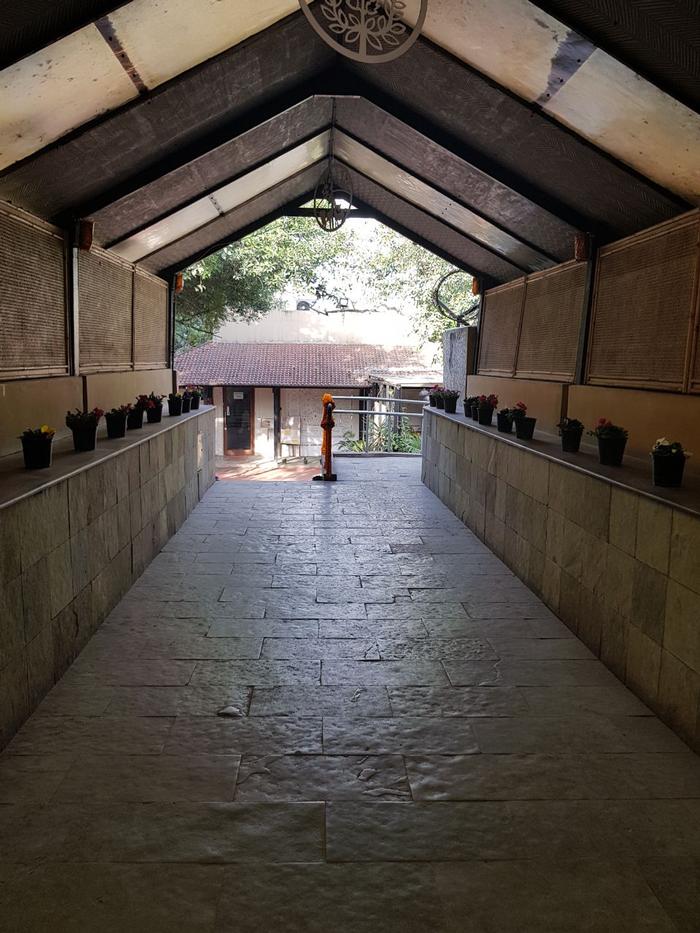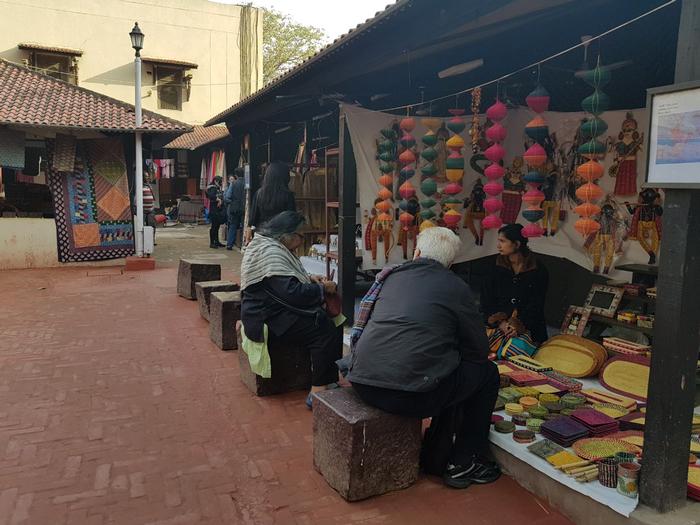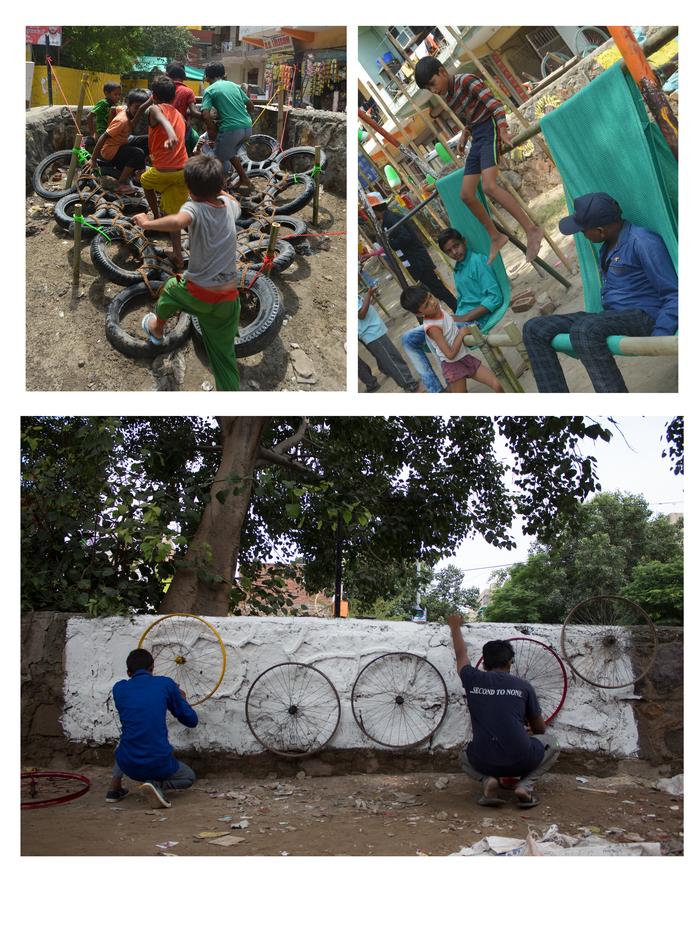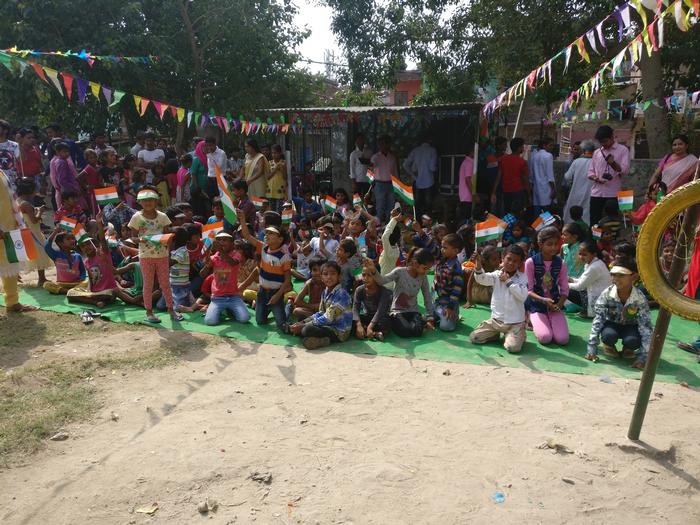[ID:2611] From Product to Process: Crafting Social GoodIndia ABSTRACT
With this essay we begin to explore social as an experience. An experience that makes us feel connected to the society. An experience we can all identify with. It binds us to each other and the society. While exploring social as an experience, we try to express it in tangible terms, to identify a social space.
Four aspects of a social space are identified with the help of the example of National Crafts Museum in Delhi. After identifying what makes a space social, we look for another recent example in Delhi. The transformation of a disused park in Hasanpur village, East Delhi is taken as the second example. Taking these two contrasting examples for the essay, we attempt to look beyond the physical differences and features of the end product. We focus on the process to understand what makes a space social. We find commonalities in the two examples that are built years apart and are very different in their physical character. Community participation we realised has played an integral part in both, however more in one than the other. We look at the ways in which the community participates and how it benefits the society. Through this we attempt to understand what can be a good model for social architecture in future.
THE SOCIAL EXPERIENCE
Seeking to answer the complex question of social art of architecture, we revisited spaces that our mind still associated with the inexplicable feeling of somehow being connected-connected to one another and the society. The connection we felt while waving at our friends from the balconies of our houses; the connection we felt while playing cricket and pitthoo in our gullies (streets); or simply the connection we felt exchanging stories with complete strangers sipping hot tea at the corner thela(stall), the feeling of being connected has remained the same across time and place. Social, we realized is not bound by the tangible, but is a feeling and an experience.
Jogging down the memory lane to revisit the spaces where we experienced a similar connection, we were reminded of the National Crafts Museum in Delhi. Its memory remained fresh still owing to its frequent mention in conversations with our parents and even grandparents, re-instating its popularity across generations. We wondered what is the experience of feeling social; particularly we wondered what lends the museum the characteristic of being social. Deciding to comprehend this, we revisited the National Crafts Museum, New Delhi by Ar. Charles Correa.
RE – VISITING THE MUSEUM
Stepping from a noisy and large scale arterial road into the museum premises, we instantly felt a change of scale articulated by the effortless composition of built with nature. The scorching Indian sun was filtered out by the semi-open entrance pavilion. As we walked further, it seemed where the built ended, nature took over. The task of being the giver of shade and shelter was shared by built and nature within the interconnecting courtyards. This created a comfortable human scale setting that allowed one to breathe and look around. The comfort of human scale and the openness of space instilled permeability in people to newer thoughts and ideas by observation and absorption. Within the courtyards were a host of varied interactions – between the community of craftspeople and their interaction with the visitors. We felt at ease sitting on the steps and stone platforms at the interface of the private working zone and the public courtyard. The transition from private to public at this interface was seamless, with a blurred intermediate zone that became a social interaction space. This is where we overhear a conversation. Two crafts persons each from different ends of the country narrate to each other, stories of their life and share their passion for their craft. While we observe this exchange, a child walks up to the old Sholapith craftsperson from Bengal, sitting across us. With his inquisitive eyes, he looks at the skilled hands of the crafts person moving swiftly. The craftsperson looks up and smiles, performs the same action, this time slowly, as if to explain it to the child, helping him absorb it all. In spite of not sharing the same language, they share knowledge. This space give them a platform to interact with one another. Here we realized, when interaction is not a mere necessity, but prevails still in its favorable environment, the space becomes social.
The earthiness and the rural sensibilities of the space bound different people otherwise belonging to different regions. As the craftspeople work in their private zones yet side by side, they again bond on their shared identity of being craftspeople. When this identification transforms an individual to a part of the society, the space becomes social.
As Jyotindra Jain has written, “the whole museum is conceived after the timeless world of the Indian village where otherwise incompatible crafts exist side by side.” The simple courtyards provide an unbiased piece of architecture that appeal to all. At the same time, there are snippets of architecture of regions all over India- be it in the form of a Rajasthani Gate or a Bengali hut. This makes for an appropriate balance of universal and regional. In this atmosphere, the craftspeople bond on their similarities and learn from each other’s differences. When there is a shared value that the society identifies with, the space becomes social.
TANGIBLE ASPECTS OF SOCIAL
Re-visiting the museum we identified the experience that made a place social. Here we realized, When interaction is not a mere necessity, but prevails still in its favorable environment, the space becomes social. When its inherent openness instills permeability in people, to newer thoughts and ideas engulfing the whole of the senses, the space becomes social. When there is a shared value that the society identifies with, the space becomes social. When this identification transforms an individual to a part of the society, the space becomes social.
Equipped with the knowledge of what is social, we set on a quest to find these values in a contemporary space. What we ended up finding was a space executing the same values but through drastically different means.
HASANPUR VILLAGE
Walking down the primary road of Patparganj in East Delhi, we chanced upon hearing animated sounds of children. Turning around, we saw a park that greeted us with the sight of chirpy children excitedly climbing a quirky tire playscape. Passing through the path inside the park, we could now see the whole of the park. We in that moment felt like a part of the lively atmosphere. In another part of the park were elders, discussing the daily happenings as they comfortably sat on bamboo benches under the shade of trees. Like the Crafts Museum, the comfort here (both physical and mental), made conversations flow easily and naturally, as we in no time struck a conversation with the users of the park.
This park, we came to know is an irregularly shaped piece of land edging the extremely dense Hasanpur Village. With no space for recreation within the village, the park forms a valuable open space for the villagers. A playground for children, space for discussion for village elders, space for recreation, and a space for celebration for the community, the ground holds different meanings for different people. It is here that the village comes together as a society, and realizes its collective identity. With the installation of dustbins and anti-litter posters put all around the park by the locals, the shared ownership of the park again binds the locals together as a society. However, to our utter surprise we came to know that the utilization of this space as a park has only been a recent development. In stark contrast to the present scenario, the space earlier was a garbage dump yard. In fact, the space was earlier deemed so unhygienic and unsafe that people even avoided roaming around the space, let alone inside it. Curious, we decided to know more about this drastic transition. A bunch of college students had contacted locals about revamping the space into a park a few months back. Brainstorming together, the students and the locals identified the problem of the lack of a recreational space for the village. Adopting the Light Cheap Quick(LCQ) approach, they converted the dump yard into a vibrant recreational space. By upcycling waste materials, the locals built a playscape for children. Tire hills, swings made using ropes and bamboos, interactive sound installations made using waste cans and bottles-the park in no time became the favourite spot for children. By painting the walls, the locals not only created an instantaneous change of image for the space, but also bonded together in the process. Identifying spots under the shade of trees, low cost brick and bamboo benches were also collectively created by the locals and the students. Thus, in the end, the users became the thinkers and the executers, as they together converted a space into exactly what they needed. The LCQ Approach helped to quickly tap the momentum of the ongoing need of the requirement of a recreational space to convert the community’s vision into reality. Most importantly, the approach also gave the flexibility of tweaking the results for further success. The low-cost solutions ensured an all-inclusive participation by the community-anybody could contribute, anybody could build to create a space that anybody could use. This highlighted an entirely new perspective, a shift in focus from the final product to process.
COMPARATIVE ANALYSIS OF CASE STUDIES
Though executing the same experiential values, the two examples achieve these through drastically different physical characteristics. One represents a permanent and timeless structure designed and executed under an expert. The other is ephemeral, designed and altered as per changing user needs.
Crafts museum uses local commercially available material carefully selected to curate a certain experience and visual texture. While the intervention at Hasanpur Village has predominantly up – cycled waste materials. These were easily available in households, thus were easily collected and contributed by the individuals in the community. The two examples also differ in the type of user experience. The crafts museum is a carefully orchestrated user experience designed by architect Charles Correa unlike the experience at Hasanpur. The rudimentary needs of the path, playscape and seating determine the architecture of the park. These three functions triangulate and work with each other to create a vibrant piece of social architecture.
The flexible furniture gives the park multiplicity of usage, sometimes a playscape and an area for discussion, the other times an open ground for community gathering. The function and experience changes with changing user needs and time. Crafts museum continues to perform the same function of being a platform for display of crafts and heritage. Here, the craftspeople keep changing, changing with them the crafts that ornament the simple courtyards of the museum. Both the examples are a product of community participation; however, it is done differently in both.
SOCIAL GOOD THROUGH COMMUNITY PARTICIPATION
We realise how the community's involvement has led to the park's success when We meet little Rani at Hasanpur. She shows us her art work - her tiny hands imprinted on the walls of the park using bright and vivid colours. Now, she devotedly ensure that nobody litters around her piece of art. Many like her contributed in myriad ways in the transformation and success of this social space.
The community contributed in all aspects of the transformation- decision making, doing hands on work in the building process, supervision of work, giving refreshments and contribution of raw materials. Thus, the decision to transform the space was taken by those who were to occupy it, ensuring greater chance of success of the space. Most importantly, this created a sense of belonging of the community to the park. As a result, this led to better utilization and maintenance of the park. Those who littered the space earlier, now have installed dustbins in the park.
At the National Crafts Museum, on the other hand, the community actively participates as users of the space. Every fortnight, a different set of craftspeople transform and enrich the basic space created by Correa. Sometimes a bright Madhubani painting stands in contrast to the earthy courtyards, sometimes a bamboo weave compliments it. Both provide a different experience. Thus, community participation here helps prevent monotony by transforming the space in a different manner.
CONCLUSION – MODEL FOR FUTURE
Having established that community participation is intrinsic to the formation of social spaces, we wondered if it holds the key to the future of successful social spaces. We inferred from the above two examples, that even though both involve the community, only one involves it in a more all-embracing manner. Involvement of the community in the use of the space is common to both. However, involvement in decision making at Hasanpur Village is the key factor that differentiates the two.
All groups within the community- children, young, elderly, women, men were involved in the process of building indirectly or directly. Hands on work requires time, energy and strength- hence, it was done mainly by the community youth. Raw materials were provided by people who owned them already and thus, could not be provided by all. Supervision to the building process was provided by those who had time and wisdom- the retired elderly. However, one aspect of community participation was not bound by time, strength or money. The only aspect that did not involve this was decision making. It only required having a need, being part of the community and simply the will to do good to the community. All groups in Hasanpur Village articulated their needs that were to be provided for. This ensured the success of the space since every nook and corner catered to a need. It is important to note that the key for inclusivity here, was the inclusive process of decision.
This is no way undermines the success of crafts museum as a social space. Charles Correa being exceptionally gifted, accurately interpreted and translated the various needs of the community into good social architecture. However, this may not be possible always. Therefore, involvement of the entire community in the process through decision making ensures a greater chance of success of the space. In fact, collective decision making for community good is in itself a social process. This gives a chance of involvement to those who cannot contribute to the building process directly but play a key role in shaping the space. In the age where our world is constantly intermingling and getting globalised, it is imperative that every group is well represented. Thus, community participation may be the key for equitable, efficient and sustainable social spaces.
If you would like to contact this author, please send a request to info@berkeleyprize.org. |




